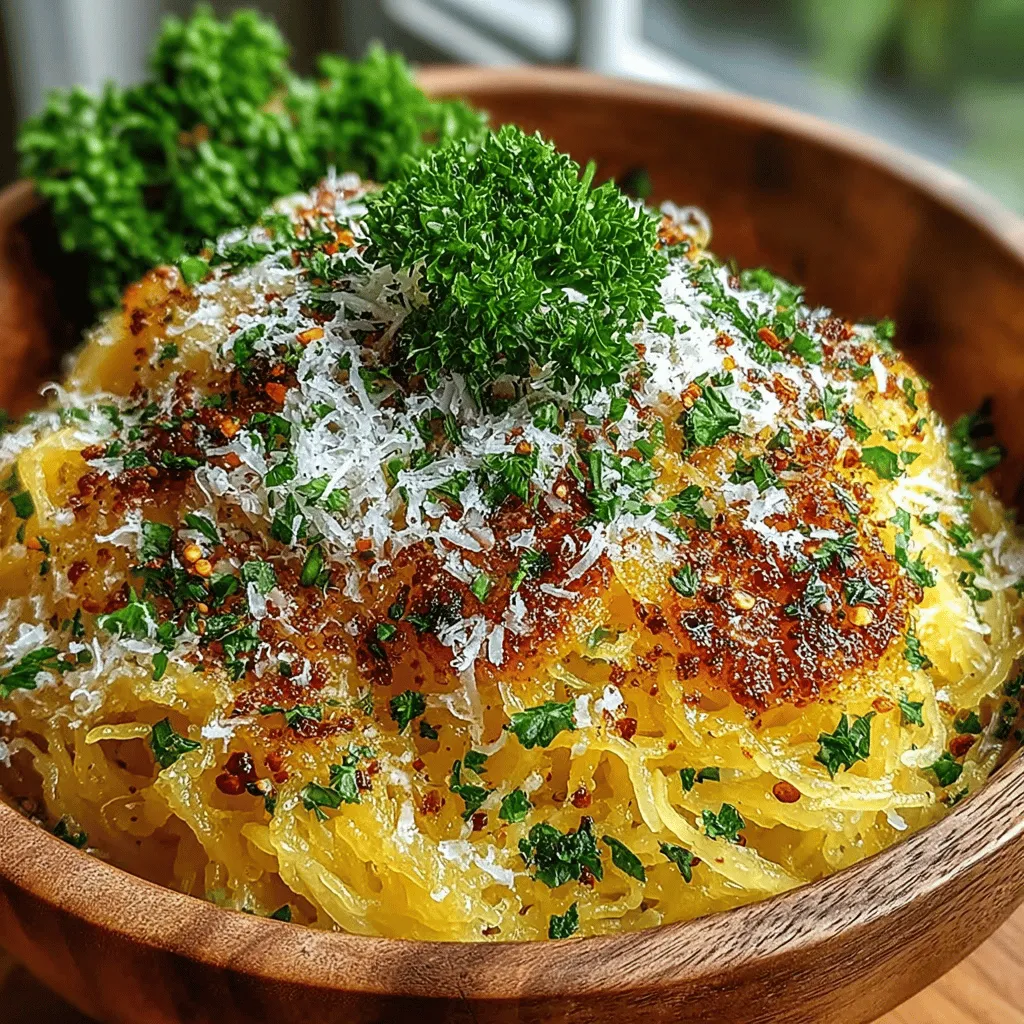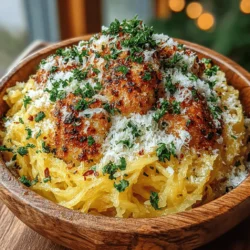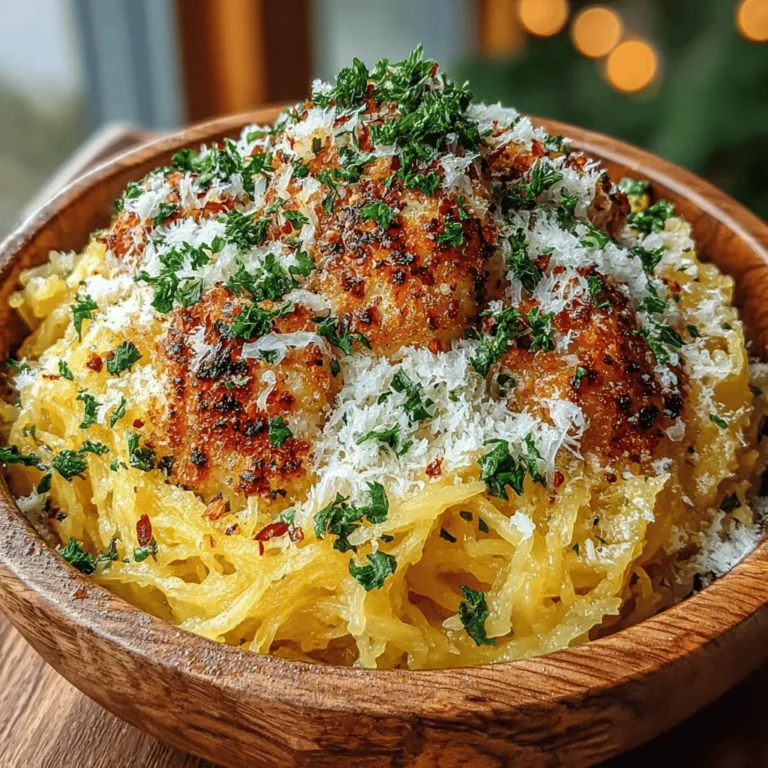Introduction: Discovering the Delight of Roasted Garlic and Parmesan Spaghetti Squash
In the ever-evolving world of healthy eating, spaghetti squash has emerged as a star player, offering a delightful alternative to traditional pasta. This versatile vegetable has captured the hearts of health-conscious individuals and those looking to incorporate more wholesome ingredients into their meals. Its unique texture and mild flavor make it an ideal canvas for a variety of toppings and sauces, allowing it to shine in both savory and sweet dishes.
As people become more aware of dietary choices, spaghetti squash has gained popularity among those pursuing low-carb lifestyles, gluten-free diets, or simply a more plant-based approach to eating. This culinary gem is not just a trend; it’s a nutritious option that boasts a low calorie count while providing a satisfying, noodle-like experience. When paired with the rich flavors of roasted garlic and the sharp, nutty essence of Parmesan cheese, spaghetti squash transforms into a dish that is both wholesome and indulgent, perfect for a cozy dinner or entertaining guests.
Understanding Spaghetti Squash: Nutritional Benefits and Culinary Uses
Spaghetti squash is not only a delicious alternative to pasta but also a nutritional powerhouse. A typical serving of cooked spaghetti squash contains roughly 42 calories, making it an excellent choice for those watching their calorie intake. The fiber content is impressive as well, with about 10 grams per squash, promoting digestive health and keeping you feeling full longer. Additionally, spaghetti squash is rich in essential vitamins and minerals, including vitamin C, vitamin B6, and potassium, contributing to a balanced diet.
Culinary versatility is another hallmark of spaghetti squash. While it is commonly associated with savory dishes, this squash can also be used in sweet applications, such as in baked goods or desserts. Its mild flavor allows it to absorb the essence of accompanying ingredients, whether they’re herbs, spices, or rich sauces. From roasted vegetable medleys to creamy Alfredo-inspired dishes, spaghetti squash can adapt to a myriad of culinary styles, making it a staple in many kitchens.
Ingredients Spotlight: Essential Components for a Flavorful Dish
Creating a dish as delightful as Roasted Garlic and Parmesan Spaghetti Squash requires a careful selection of ingredients, each contributing its unique flavor and texture. Let’s take a closer look at the essential components that make this recipe a standout.
– Spaghetti Squash: The star of the dish, spaghetti squash, boasts a unique fibrous texture that, when cooked, separates into strands resembling traditional spaghetti noodles. This vegetable serves as a nutritious base that absorbs flavors beautifully, making it perfect for a variety of toppings and sauces.
– Garlic: Renowned for its aromatic qualities, garlic is a crucial ingredient that elevates the dish to new heights. Beyond its flavor, garlic is celebrated for its numerous health benefits, including immune system support and anti-inflammatory properties. Roasting garlic mellows its pungency, resulting in a sweet and savory essence that enhances the overall flavor profile of the dish.
– Olive Oil: The quality of olive oil used in this recipe can significantly enhance the flavor. A high-quality extra virgin olive oil adds depth and richness to the roasted garlic and spaghetti squash, while also providing healthy monounsaturated fats. The oil helps to caramelize the garlic, creating a beautifully roasted flavor that permeates the entire dish.
– Italian Seasoning: This blend of herbs typically includes oregano, basil, thyme, and rosemary. Italian seasoning is a staple in Italian cuisine, and its aromatic qualities complement the garlic and squash perfectly. This medley of herbs adds warmth and complexity to the dish, making each bite a flavorful experience.
– Parmesan Cheese: Known for its distinct sharpness and nutty flavor, Parmesan cheese adds a luxurious creaminess to the dish. When sprinkled on top of the roasted spaghetti squash, it melts slightly, creating a savory layer that ties all the flavors together. Parmesan is also a great source of protein and calcium, enhancing the nutritional value of the dish.
– Fresh Parsley: This vibrant herb serves as a garnish, adding a pop of color and a fresh, herby flavor that brightens up the dish. Parsley is not only visually appealing but also contributes vitamins A, C, and K, making it a healthy addition.
– Optional Ingredients: For those who enjoy a little heat, crushed red pepper flakes can be added for an extra kick. This simple addition can elevate the dish’s flavor complexity, balancing the richness of the cheese and the sweetness of the roasted garlic.
Step-by-Step Guide to Preparing Roasted Garlic and Parmesan Spaghetti Squash
Now that we’ve explored the enticing elements of this dish, it’s time to dive into the preparation process. Here’s a comprehensive step-by-step guide to making Roasted Garlic and Parmesan Spaghetti Squash, ensuring clarity and ease for every home cook.
Step 1: Preheat Your Oven
Begin by preheating your oven to 400°F (200°C). A properly heated oven is essential for achieving the perfect roast on the garlic and spaghetti squash, ensuring that they develop a rich, caramelized flavor.
Step 2: Prepare the Spaghetti Squash
Next, take your spaghetti squash and carefully slice it in half lengthwise. Use a sharp knife for this task, as the skin can be tough. Once halved, scoop out the seeds and stringy flesh in the center using a spoon. You want to create a hollow space for the roasting process.
Step 3: Season the Squash
Drizzle the inside of each half with olive oil, then sprinkle with salt, pepper, and Italian seasoning. Make sure to rub the spices and oil into the flesh to ensure even flavor distribution. Placing the squash cut-side down on a baking sheet lined with parchment paper will help it cook evenly.
Step 4: Roast the Squash
Place the prepared squash in the preheated oven and let it roast for about 40-50 minutes, or until the flesh is tender and easily pierced with a fork. The roasting time can vary based on the size of the squash, so check it regularly.
Step 5: Prepare the Garlic
While the squash roasts, it’s time to prepare the roasted garlic. Take a whole head of garlic and slice off the top to expose the cloves. Drizzle the exposed cloves with olive oil and wrap the head in aluminum foil. The foil will help steam the garlic, resulting in a sweet, caramelized flavor.
Step 6: Roast the Garlic
Place the wrapped garlic in the oven alongside the spaghetti squash during the last 30 minutes of roasting. This allows the garlic to soften and caramelize, developing its characteristic sweet taste that will enhance the dish.
Step 7: Fluff the Squash
Once the spaghetti squash is roasted and fork-tender, remove it from the oven and let it cool slightly. After a few minutes, use a fork to scrape the flesh of the squash, creating spaghetti-like strands. This is where the magic happens; the squash transforms into a delicious, noodle-like base ready for flavor.
As you continue with the recipe, you’ll soon combine these elements into a dish that’s not only healthy but also brimming with flavor. The next steps will involve incorporating the roasted garlic and finishing touches, leading you to a beautifully plated Roasted Garlic and Parmesan Spaghetti Squash. Stay tuned for more on how to bring this delightful dish to life!

Preheating the Oven
Preheating your oven is a crucial step in achieving perfectly roasted spaghetti squash. The ideal temperature for roasting is 400°F (200°C). This high heat allows the squash to caramelize slightly, enhancing its natural sweetness and providing a wonderful texture. If you skip this step, you may end up with uneven cooking, resulting in a mushy texture rather than the desired spaghetti-like strands. While your oven is preheating, you can prepare the squash, ensuring everything is ready for an efficient cooking process.
Preparing the Spaghetti Squash
When it comes to preparing spaghetti squash, safety is paramount. Start by selecting a firm and heavy squash, as this indicates ripeness. To cut the squash safely, place it on a stable cutting board. Use a sharp chef’s knife to slice off both ends of the squash; this creates a flat surface, making it easier to cut in half. Proceed by carefully slicing the squash in half lengthwise. If you encounter resistance, you can microwave it for a minute or two to soften the skin slightly.
Once halved, scoop out the seeds and stringy insides with a spoon. This will help you achieve those perfect spaghetti strands later. Be sure to keep the shells intact, as they will serve as natural bowls for serving once the squash is cooked.
Seasoning the Squash
Seasoning is key to elevating the flavors of roasted spaghetti squash. After you’ve prepared the squash, drizzle each half with olive oil, ensuring every surface is coated. Season generously with salt and freshly ground black pepper. For added depth of flavor, consider sprinkling in garlic powder or dried herbs like thyme or oregano. The seasoning not only enhances the flavor of the squash but also complements the roasted garlic and Parmesan that will be added later.
Roasting Process
Roasting the squash takes about 40-50 minutes at 400°F (200°C). Place the squash halves cut-side down on a baking sheet lined with parchment paper. This helps to trap the moisture, leading to tender strands. To check if the squash is perfectly roasted, use a fork to scrape the flesh gently. It should easily separate into spaghetti-like strands and be tender to the bite. If you encounter any resistance, return the squash to the oven for an additional 5-10 minutes, checking periodically until done.
Making the Garlic Oil
While the squash roasts, you can prepare the garlic oil that will infuse the dish with flavor. In a small saucepan, heat about ¼ cup of olive oil over medium heat. Once the oil is warm, add finely minced garlic (approximately 4-5 cloves) to the pan. Sauté the garlic gently, stirring frequently to prevent it from burning. Cook until the garlic turns golden and fragrant, which usually takes 2-3 minutes. Be careful not to overcook it, as burnt garlic can impart a bitter taste to your dish. Once done, remove the pan from the heat and set it aside.
Mixing the Ingredients
Once your spaghetti squash is roasted and your garlic oil is ready, it’s time to bring everything together. Carefully flip the squash halves over and use a fork to scrape out the spaghetti strands into a large mixing bowl. Drizzle the garlic oil over the strands and toss gently to combine, ensuring that the garlic is evenly distributed. Next, add freshly grated Parmesan cheese (about ½ cup) and toss again until the cheese melts slightly and coats the strands. For an extra touch of flavor, consider adding a squeeze of fresh lemon juice or a handful of fresh parsley for color and freshness.
Serving Suggestions
Presentation is key, especially when serving a dish as visually appealing as roasted garlic and Parmesan spaghetti squash. Serve the squash directly in its shell for a rustic look or pile the strands into a bowl. Garnish with additional Parmesan cheese, a sprinkle of freshly chopped herbs, or a drizzle of balsamic reduction for an elegant finish. Pair your dish with a light salad or some crusty bread to complete the meal.
Flavor Enhancements: Customizing Your Spaghetti Squash
One of the most delightful aspects of spaghetti squash is its versatility. Here are some ways to personalize your dish:
– Adding Protein: To create a more substantial meal, consider adding grilled chicken, shrimp, or chickpeas. These protein additions not only enhance the dish’s nutritional value but also contribute to a fulfilling dining experience.
– Vegetable Add-Ins: Boost the nutritional content by incorporating sautéed vegetables like spinach, bell peppers, or zucchini. These add color, texture, and additional flavors, making your dish even more vibrant and satisfying.
– Spice Variations: Experiment with different herbs and spices to customize the flavor profile. Fresh basil, red pepper flakes, or Italian seasoning can add an exciting twist to the dish. If you enjoy a bit of heat, try adding a pinch of chili flakes or mixing in some crushed garlic for an extra kick.
Health Considerations: Why Choose Spaghetti Squash?
Choosing spaghetti squash over traditional pasta comes with numerous health benefits. This nutrient-dense vegetable is low in calories and carbohydrates, making it an excellent option for those looking to manage their weight. It’s also high in fiber, which aids digestion and helps maintain steady blood sugar levels. For those following gluten-free or paleo diets, spaghetti squash is a fantastic alternative that allows you to enjoy the comfort of pasta without the gluten.
Furthermore, spaghetti squash is rich in vitamins, particularly vitamin C and B vitamins, which are essential for energy and overall wellness. Incorporating this vegetable into your meals can help you feel satisfied while still adhering to your dietary goals.
Conclusion: Savoring the Simplicity and Flavor of Roasted Garlic and Parmesan Spaghetti Squash
Preparing and enjoying roasted garlic and Parmesan spaghetti squash is a delightful experience that combines simplicity with rich flavors. The process of roasting transforms the squash into a tender, spaghetti-like dish that serves as a blank canvas for various flavor profiles. With minimal ingredients and straightforward cooking techniques, this recipe not only fits seamlessly into a balanced diet but also makes for an impressive centerpiece at any meal.
Whether you’re looking for a healthy alternative to pasta, a side dish, or a main course, this roasted garlic and Parmesan spaghetti squash is sure to please. Embrace the ease and flavor of this dish, and consider adding it to your regular cooking repertoire. Your taste buds—and your body—will thank you!


